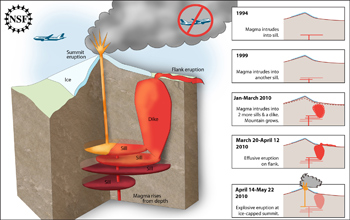News Release 10-219
Months of Geologic Unrest Signaled Reawakening of Icelandic Volcano
Monitoring volcanoes helps researchers understand the processes that drive them to erupt

Schematic showing "plumbing" of Eyjafjallajökull volcano in Iceland and timing of its acti
November 18, 2010
This material is available primarily for archival purposes. Telephone numbers or other contact information may be out of date; please see current contact information at media contacts.
Months of volcanic restlessness preceded the eruptions this spring of Icelandic volcano Eyjafjallajökull, providing insight into what roused it from its centuries of slumber.
An international team of researchers analyzed geophysical changes in the long-dormant volcano leading up to its eruptions in March and April 2010. In a study published in the Nov. 18 issue of the journal Nature, the scientists suggest that magma flowing beneath the volcano may have triggered its reawakening.
"Several months of unrest preceded the eruptions, with magma moving around downstairs in the plumbing and making noise in the form of earthquakes," says study co-author Kurt Feigl, a professor of geoscience at the University of Wisconsin-Madison. "By monitoring volcanoes, we can understand the processes that drive them to erupt."
Feigl's research was funded in part by the National Science Foundation through a RAPID award (Grant for Rapid Response Research).
More information on this work is available in the University of Wisconsin-Madison press release.
-NSF-
Media Contacts
Maria C. Zacharias, NSF, (703) 292-8454, email: mzachari@nsf.gov
Jill Sakai, University of Wisconsin-Madison, 608-262-9772, email: jasakai@wisc.edu
The U.S. National Science Foundation propels the nation forward by advancing fundamental research in all fields of science and engineering. NSF supports research and people by providing facilities, instruments and funding to support their ingenuity and sustain the U.S. as a global leader in research and innovation. With a fiscal year 2023 budget of $9.5 billion, NSF funds reach all 50 states through grants to nearly 2,000 colleges, universities and institutions. Each year, NSF receives more than 40,000 competitive proposals and makes about 11,000 new awards. Those awards include support for cooperative research with industry, Arctic and Antarctic research and operations, and U.S. participation in international scientific efforts.
Connect with us online
NSF website: nsf.gov
NSF News: nsf.gov/news
For News Media: nsf.gov/news/newsroom
Statistics: nsf.gov/statistics/
Awards database: nsf.gov/awardsearch/
Follow us on social
Twitter: twitter.com/NSF
Facebook: facebook.com/US.NSF
Instagram: instagram.com/nsfgov


